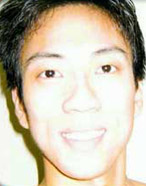 |
||
|---|---|---|
| CP Foundation | About CP Biennale | 2003 | 2005 | Contact Us | >||
           
|
||
|
For this biennale, the artist, who had graduated from the department of architecture at the Parahyangan Catholic University in Bandung, chooses some portable media as his subject matter. In Portable Love Moods, the parts--the circle with the portrait of Aditya and the metallic circle next to it--are interchangeable and interconnectable. The audience can whimsically play with Aditya pin-ups and turn the geometric circles, responding to the various icons and ornaments he provides. Portable Living Box, meanwhile, is a cube whose sides are adorned with paintings. Aditya paints various symbols and icons such as the human anatomy, traditional houses, and the figure of Buddha. "This is all about artistic objects that can interact with the viewers," Aditya explains. A symbolic play on the prohibition found in many galleries: "Don't Touch, Please!". There has been a significant shift in Aditya's artistic tendency. His early works betrayed the easy childhood simplicity, while his works during adolescence revealed his search for a visual identity. Today, his works tell of his efforts in calculating the composition and the logic of his objects' mechanical functions. Aditya's ego is present within his objects as the "I", while the objects become a game. Here Aditya opens himself up for outside interference, he lets the audience to play around with him. It can be said that the work reveals his ideas to explore the concept of "I - Aditya," how the "I" arranges itself and at the same time is being arranged by someone else. "The idea is about portability," he explains, "The idea becomes complete when you, as a viewer, touch it, move it, and play with the objects repeatedly." The matter of identity, which the game symbolizes, often resurfaces in the works of many contemporary artists. Indeed, Aditya and the world today are present in the midst of globalization, a situation that forces many to seek their identities. While we witness many symbols and signs of identity float around us, an artwork can form an access to some identity formations. I see that in Aditya's works. Sudjud Dartanto Born in Solo, November 17, 1978. SELECTED GROUP EXHIBITIONS 2002 Indofood Art Awards 2002, National Gallery, Jakarta; Group Exhibition, Gema Seni Indonesia, Cultural Centre, Surakarta. |
||
|
CP Foundation | About CP Biennale | 2003 | 2005 | Contact Us
Jl. Suryopranoto 67A, Jakarta 10160, Indonesia. ph. +62.21.3448126, 3853206 | fax. +62.21.3853203, 3853208 info@cp-foundation.org |
||
 Aditya Novali's artistic history begins in his childhood. Some art observers have marked him as a high-spirited painter. As a child, Aditya was already well known as a puppet master. We thus come to understand that Aditya had been intimately acquainted with the world of wayang, a traditional world most would readily dismiss today. All through his childhood, adolescence, and adulthood, Aditya has been visualizing his artistic ideas and opinions using paintings, sketches, and drawing--as evident in the catalogues he keeps. In his studio in Solo, we can read various notes on his artistic achievements since his early childhood.
Aditya Novali's artistic history begins in his childhood. Some art observers have marked him as a high-spirited painter. As a child, Aditya was already well known as a puppet master. We thus come to understand that Aditya had been intimately acquainted with the world of wayang, a traditional world most would readily dismiss today. All through his childhood, adolescence, and adulthood, Aditya has been visualizing his artistic ideas and opinions using paintings, sketches, and drawing--as evident in the catalogues he keeps. In his studio in Solo, we can read various notes on his artistic achievements since his early childhood.